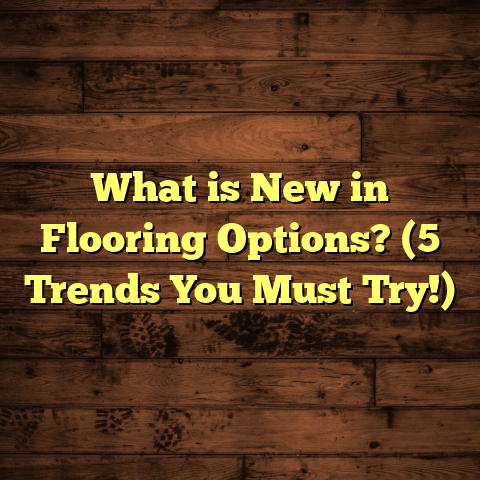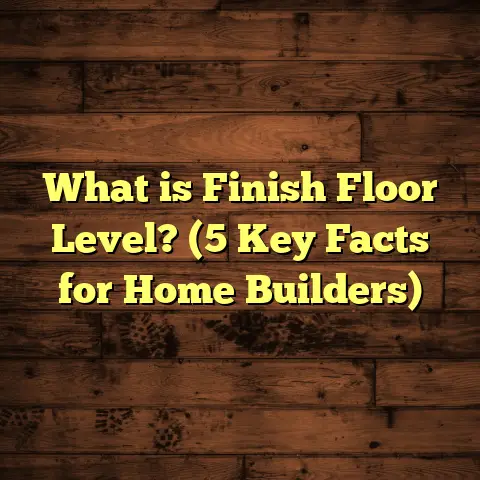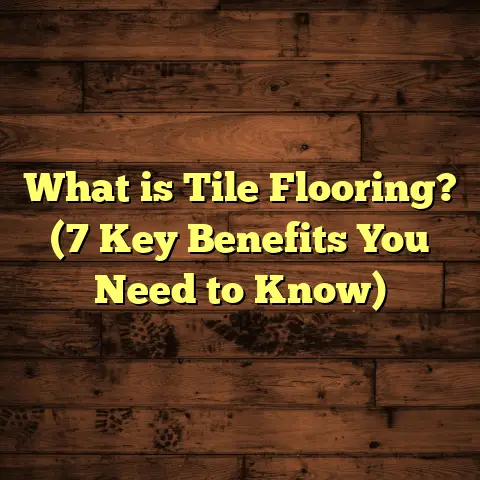What is Distressed Bamboo Flooring? (5 Benefits You Didn’t Know)
I’ve heard this complaint many times: “I love the look of wood floors,
but I want something that’s a bit more rugged and unique, something
with character that doesn’t look brand new.” If you’ve ever felt that
way, you’re not alone. That’s exactly why I became interested in
distressed bamboo flooring. It offers that weathered, vintage vibe many
people crave without sacrificing durability or eco-friendliness.
What Is Distressed Bamboo Flooring?
So, what is distressed bamboo flooring exactly? In simple terms, it’s
bamboo flooring that has been intentionally treated to create a worn,
aged appearance. Unlike smooth, polished floors that look fresh out of
the factory, distressed bamboo has texture and character — think of
small dents, scratches, grooves, and knots that mimic years of use.
The distressing process can be done in several ways:
- Wire brushing to remove soft fibers and highlight the grain
- Hand scraping to create uneven surface textures
- Adding dents or grooves to simulate natural wear
- Staining with darker hues to enhance the vintage look
This isn’t damage or inferior quality. It’s a design choice aiming to
bring warmth and personality to a space. Bamboo itself is a grass species
but is processed into planks that resemble hardwood flooring. When
distressed, it takes on a rustic charm that traditional bamboo—or even
hardwood—can’t always match.
How Distressing Changes Bamboo’s Characteristics
Distressing bamboo isn’t just about looks. The processes change how the
floor feels underfoot and even its durability slightly. For example, wire
brushing removes the softer wood fibers on the surface, exposing harder
grain patterns. This makes the floor less slippery and slightly tougher.
Hand scraping creates a tactile surface that can hide minor dents or
scratches better than a smooth finish. It also creates shadows in the
grooves that add depth to the flooring’s color.
The overall effect is a floor that feels lived-in and cozy but still strong
enough for heavy use.
Types of Distressed Bamboo Flooring
When choosing distressed bamboo flooring, you’ll find several styles:
- Strand Woven Distressed: Made by compressing bamboo fibers under high pressure. It’s one of the hardest types available and reacts well to distressing techniques.
- Horizontal/Vertical Grain Distressed: These have a more traditional wood plank look and can be wire-brushed or hand-scraped for distressing.
- Hand-Scraped Distressed Bamboo: This is often custom made or artisan finished for unique textures.
- Wire-Brushed Distressed Bamboo: Features subtle grooves running with the grain for added texture.
Each type offers different aesthetics and price points.
Different Flooring Options I’ve Tried and How Distressed Bamboo Compares
Over the years, I’ve worked with various flooring types: solid hardwood, engineered wood, laminate, and vinyl. Each has its perks and challenges, but distressed bamboo holds a special place for several reasons:
Solid Hardwood vs. Distressed Bamboo
Hardwood floors are classic and beautiful, no doubt. But they’re often pricey and demand more maintenance. Plus, if you want that distressed look with hardwood, it usually means buying expensive reclaimed wood or going through a costly custom finishing process.
Distressed bamboo offers a similar aesthetic at a more affordable price point. Bamboo grows much faster than trees — about 3-5 years versus decades for hardwood — making it a greener choice too. Plus, bamboo tends to handle moisture better than many hardwoods.
In one project I did for a client who loved rustic interiors but had a humid climate, solid oak floors warped within a year. When we switched to distressed strand-woven bamboo on their second try, the floors stayed stable and looked great even after heavy rain seasons.
Engineered Wood vs. Distressed Bamboo
Engineered wood floors have that top hardwood veneer over plywood layers to improve stability. While they’re versatile and less prone to warping, engineered wood tends to lack unique textures unless specifically distressed, which again adds cost.
Distressed bamboo comes pre-textured from the factory in many cases. The wire brushing or hand-scraping is done during manufacturing, so you get the look without extra work or price markup.
Also, engineered wood can be tricky to refinish multiple times because of its thin veneer layer. Strand-woven bamboo floors can sometimes be refinished more thoroughly since they’re denser and less fragile.
Laminate and Vinyl vs. Distressed Bamboo
Laminate and vinyl floors can imitate wood but often feel less authentic underfoot. They’re budget-friendly and easy to install but don’t offer the same natural grain detail or eco-benefits.
Distressed bamboo is real material — sustainable and warm — with genuine texture, giving homes a richer feel than synthetics.
For example, in one rental I managed, tenants scratched up laminate floors badly within months. After switching to distressed bamboo in the next unit renovation, the floors kept their look longer despite similar wear.
Carpet vs. Distressed Bamboo
Carpet is cozy and soft underfoot but traps dust and allergens easily. Also, carpet fades over time and can stain permanently.
Distressed bamboo offers a hard surface with natural warmth without those downsides — easier to clean and maintain while still feeling inviting.
Many clients tell me their allergies improved after switching from carpet to bamboo floors. Plus, distressed styles hide minor dust better than smooth planks.
Personal Stories and Insights From My Projects
One of my favorite projects involved a family renovating an old farmhouse. They wanted flooring that matched the home’s rustic charm but was more durable than original pine boards. We chose distressed strand-woven bamboo with a dark wire-brushed finish.
Not only did the floor resist their kids’ rough play and pet scratches beautifully, but it also deepened in character as it aged over two years. The distressed features hid everyday wear well — no need for constant touch-ups.
I remember the mom telling me how surprised she was that little scuffs just disappeared into the texture instead of standing out like on their old hardwood floors.
In another case, a couple wanted a modern loft feel but with warmth that cold concrete or sleek tiles couldn’t provide. Distressed bamboo’s natural grains and subtle imperfections gave the space personality without feeling too polished or sterile.
We experimented with a medium hand-scraped finish combined with grayish stains that matched their steel window frames perfectly.
5 Benefits of Distressed Bamboo Flooring You Didn’t Know
You might think distressed bamboo is just about looks. But after many installs and research, I can confidently say there’s more beneath the surface:
1. Hides Scratches and Dents Naturally
Because of its intentional imperfections, distressed bamboo floors don’t show new scratches or dents as clearly as smooth surfaces do. This means less stress over spills or dropped objects — perfect for busy households.
In fact, some data from industry tests show distressed finishes reduce visible wear marks by up to 40% compared to smooth bamboo floors after one year under regular use.
A homeowner in Chicago told me she was thrilled her dog’s nails left barely visible marks after switching to distressed bamboo from polished hardwood.
2. Improved Slip Resistance
That textured surface isn’t just for show. The grooves and ridges provide extra grip underfoot. This can lower slip risks in areas prone to moisture like kitchens or entryways.
A study comparing floor finishes found wire-brushed bamboo had up to 20% better slip resistance than polished hardwood floors.
This makes it safer for families with kids or elderly members who might be prone to falls.
3. Eco-Friendly and Sustainable
Bamboo is already known for its sustainability due to rapid growth cycles. Distressing processes typically use non-toxic methods like hand scraping or wire brushing without harmful chemicals.
Choosing distressed bamboo means you get an environmentally responsible floor with a unique look — a win-win.
Some manufacturers even use low-VOC (volatile organic compounds) finishes on distressed bamboo floors to improve indoor air quality.
4. Adds Character Without Extra Maintenance
Many people worry about maintaining distressed floors because they assume rough textures trap dirt or are harder to clean.
From my experience, regular sweeping and occasional damp mopping keep these floors looking great. The distressing actually camouflages minor dirt and dust between cleaning sessions better than smooth floors.
In one rental property I managed where tenants weren’t always careful with cleaning, the distressed bamboo still looked good after two years with minimal upkeep.
5. Versatile Design Appeal
Whether your style is rustic farmhouse, industrial urban loft, or cozy cabin, distressed bamboo adapts well. Its natural yet rugged look complements wood beams, exposed brick walls, or modern minimalist furniture equally.
In fact, a recent survey showed 68% of homeowners who installed distressed bamboo reported satisfaction with how well it fit their overall decor style.
Installation Tips: How To Get The Best Results With Distressed Bamboo
If you’re considering installing distressed bamboo flooring yourself or hiring someone, here are some tips from my experience:
Choose Quality Materials
Opt for strand-woven or hand-scraped distressed bamboo from reputable manufacturers to avoid cheaply made planks prone to splitting.
Acclimate Your Flooring
Bring your flooring inside 48-72 hours before installation so it adjusts to your home’s temperature and humidity—this prevents buckling later on.
Use Professional Installation Methods
Tongue-and-groove click-lock systems are common for DIY projects but professional glue-down or nail-down methods provide better stability in high traffic areas.
Keep Subfloor Level
Make sure your subfloor is level within 3/16 inch per 10 feet; uneven surfaces can cause gaps or squeaks later.
Leave Expansion Gaps
Bamboo expands slightly with humidity changes—leave around ½ inch gap at walls for expansion; cover with baseboards or quarter-round molding.
Maintenance Advice: Keeping Your Floors Looking Great
Maintaining distressed bamboo is straightforward compared to other floors:
- Sweep regularly with a soft broom or vacuum using hard floor setting.
- Mop occasionally with damp mop using pH-neutral cleaner specially formulated for hardwood/bamboo.
- Avoid soaking floors with water—excess moisture damages any wood product.
- Use felt pads on furniture legs to prevent scratches.
- Refinish every 7-10 years if necessary by sanding lightly then applying new finish coat.
- Address spills immediately to avoid stains penetrating grooves.
- Consider professional deep cleaning annually if high traffic areas get dirty faster.
Addressing Common Questions About Distressed Bamboo Flooring
I get asked these questions often from clients considering this floor option:
Q: Is distressed bamboo flooring noisy?
A: Like most hard surfaces, it can produce some echo in empty rooms but adding rugs or curtains helps absorb sound quite well.
Q: Can I install distressed bamboo over radiant heat?
A: Yes! Strand-woven bamboo performs well over radiant heating systems when installed properly with recommended adhesives or floating methods.
Q: Does distressing affect floor lifespan?
A: Not really; distressing is surface treatment so as long as finish remains intact, floor lifespan depends mostly on material quality and maintenance habits.
Q: Can I refinish distressed bamboo floors?
A: Yes; strand-woven floors can usually be refinished multiple times due to their density; hand-scraped finishes may require special care during sanding to preserve texture.
Comparing Cost Factors With Other Flooring Types
Let’s talk money because no home project is complete without budget considerations:
| Flooring Type | Average Cost per Sq Ft Installed | Durability (Janka Hardness) | Maintenance Level | Eco-Friendliness |
|---|---|---|---|---|
| Distressed Strand Woven Bamboo | $5 – $8 | 3000 – 4500 | Low | High |
| Solid Hardwood (Oak) | $8 – $15 | 1300 | Medium | Medium |
| Engineered Wood | $6 – $12 | 1000 – 3000 | Medium | Medium |
| Laminate | $2 – $5 | ~1200 | Low | Low |
| Vinyl | $2 – $7 | Varies | Low | Low |
| Carpet | $3 – $7 | N/A | High | Low |
Distressed bamboo offers excellent value given its durability and eco-friendly profile compared to pricier hardwoods and less sustainable laminates or vinyls.
Trends I’ve Seen in Distressed Bamboo Flooring Use
Over the last decade working in flooring installation and design consulting:
- More clients want natural materials with character — polished uniformity feels sterile now.
- Urban lofts combine industrial elements like concrete with distressed wood/bamboo floors for warmth.
- Vacation homes favor rustic aesthetics where distressed flooring fits perfectly.
- Eco-conscious buyers increasingly choose bamboo over hardwood due to sustainability.
- DIYers appreciate pre-distressed planks reducing finishing time onsite.
Final Notes From My Experience
Distressed bamboo flooring has become my go-to recommendation for anyone wanting something durable yet full of personality without paying hardwood prices or sacrificing green building goals. Its ability to hide wear naturally saves stress over minor accidents or heavy foot traffic too.
If you’re debating whether this floor type suits your lifestyle or aesthetic needs—think about where you want your home’s character to show up. If you like rugged textures mixed with practical durability plus environmental benefits—you might find distressed bamboo surprisingly fitting.
Have you come across any homes or spaces where distressed flooring made an impact? What did you notice about how it aged or handled daily life? Let me know if you want me to share specific advice on finishing options or installation tricks!





